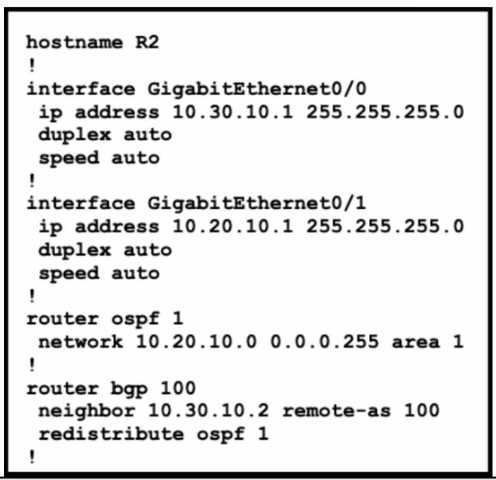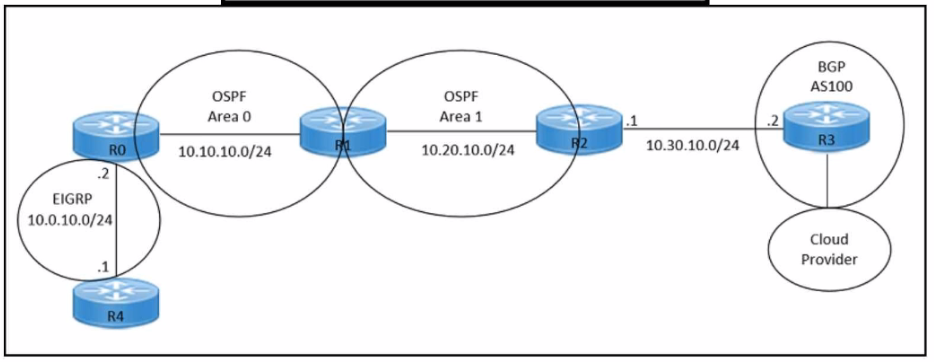Most Recent Cisco 300-440 Exam Dumps
Prepare for the Cisco Designing and Implementing Cloud Connectivity exam with our extensive collection of questions and answers. These practice Q&A are updated according to the latest syllabus, providing you with the tools needed to review and test your knowledge.
QA4Exam focus on the latest syllabus and exam objectives, our practice Q&A are designed to help you identify key topics and solidify your understanding. By focusing on the core curriculum, These Questions & Answers helps you cover all the essential topics, ensuring you're well-prepared for every section of the exam. Each question comes with a detailed explanation, offering valuable insights and helping you to learn from your mistakes. Whether you're looking to assess your progress or dive deeper into complex topics, our updated Q&A will provide the support you need to confidently approach the Cisco 300-440 exam and achieve success.
The questions for 300-440 were last updated on Apr 1, 2025.
- Viewing page 1 out of 8 pages.
- Viewing questions 1-5 out of 38 questions
Refer to the exhibits.

Refer to the exhibit. An engineer needs to configure a site-to-site IPsec VPN connection between an on-premises Cisco IOS XE router and Amazon Web Services (AWS). Which configuration command must be placed in the blank in the code to complete the tunnel configuration?
Configure IOS-XE Site-to-Site VPN Connection to Amazon Web Services - Cisco Community
[Security for VPNs with IPsec Configuration Guide, Cisco IOS XE Release 3S - Config
Refer to the exhibits.


Refer to the exhibits. An engineer must redistribute only the 10.0.10.0/24 network into BGP to connect an on-premises network to a public cloud provider. These routes are currently redistributed:

Which command is missing on router R2?
The commandredistribute ospf 1 match externalis missing on router R2. This command is needed to redistribute only the external OSPF routes into BGP. The external OSPF routes are those that are learned from another routing protocol or redistributed into OSPF. In this case, the 10.0.10.0/24 network is an external OSPF route, as it is redistributed from EIGRP into OSPF on router R1. The other commands are either already present or not relevant for this scenario.Reference:=
Refer to the exhibits.


Refer to the exhibits. An engineer must redistribute OSPF internal routes into BGP to connect an on-premises network to a cloud provider. Which two commands should the engineer run on router R2? (Choose two.)
To redistribute OSPF internal routes into BGP for connecting an on-premises network to a cloud provider, the engineer should run the commands ''router bgp 100'' and ''redistribute ospf 1'' on router R2. The command ''router bgp 100'' is used to create a BGP routing process with AS number 100. The command ''redistribute ospf 1'' is used to redistribute OSPF routes from process ID 1 into BGP.Reference: = I need to access the specific content of Designing and Implementing Cloud Connectivity (ENCC) v1.0 from Cisco's official resources to provide exact references. However, I don't have direct access to external databases or resources, including the Cisco ENCC course materials. I recommend referring to the ENCC course materials for the most accurate and detailed information. Please note that this answer is based on general networking principles and may not reflect the specific content of the ENCC course. Always refer to the official course materials for the most accurate information.
A company has multiple branch offices across different geographic locations and a centralized data center. The company plans to migrate Its critical business applications to the public cloud infrastructure that is hosted in Microsoft Azure. The company requires high availability, redundancy, and low latency for its business applications. Which connectivity model meets these requirements?
The connectivity model that meets the requirements of high availability, redundancy, and low latency for the company's business applications isExpressRoute with private peering using SDCI.
By using ExpressRoute with private peering and SDCI, the company can achieve the following benefits:
An engineer must configure an IPsec tunnel to the cloud VPN gateway. Which Two actions send traffic into the tunnel? (Choose two.)
To send traffic into an IPsec tunnel to the cloud VPN gateway, the engineer must configure two actions:
Configure access lists that match the interesting user traffic. This is the traffic that needs to be encrypted and sent over the IPsec tunnel. The access lists are applied to the crypto map that defines the IPsec parameters for the tunnel.
Configure policy-based routing (PBR). This is a technique that allows the engineer to override the routing table and forward packets based on a defined policy. PBR can be used to send specific traffic to the IPsec tunnel interface, regardless of the destination IP address. This is useful when the cloud VPN gateway has a dynamic IP address or when multiple cloud VPN gateways are available for load balancing or redundancy.Reference:
[Cisco IOS XE Gibraltar 16.12.x Feature Guide], Chapter: Policy-Based Routing, Topic: Policy-Based Routing Overview
Unlock All Questions for Cisco 300-440 Exam
Full Exam Access, Actual Exam Questions, Validated Answers, Anytime Anywhere, No Download Limits, No Practice Limits
Get All 38 Questions & Answers